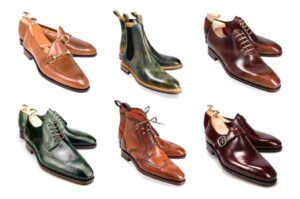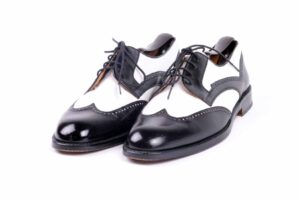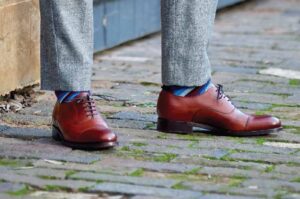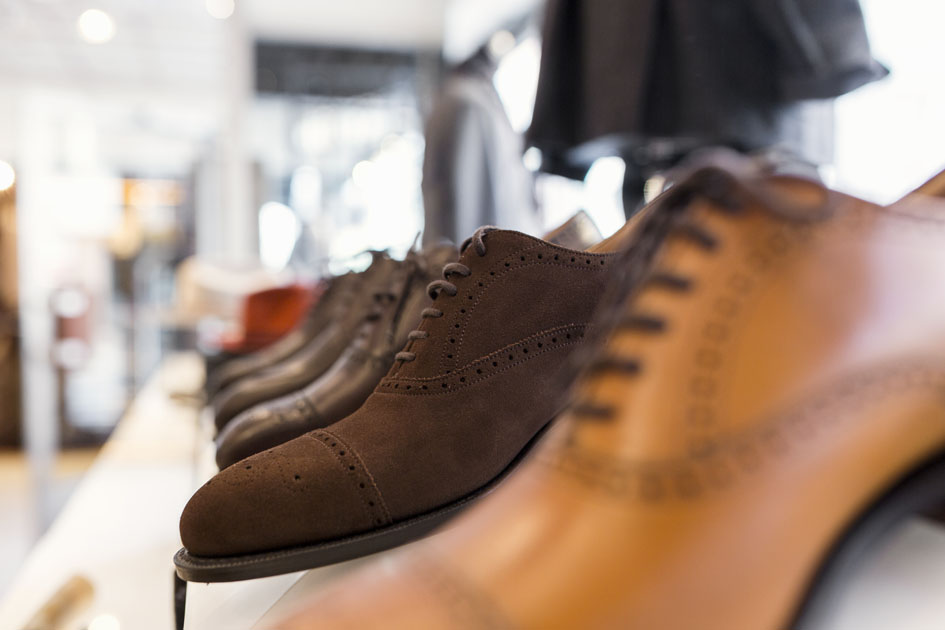
Welcome to your ultimate guide on types of leather shoes! We’ll explore the diverse world of men’s dress shoes, learn about different leathers, and even get tips on matching colorful shoes with outfits.
Ready to step up your shoe game?
Different Types of Leather Shoes
When it comes to men’s dress shoes, the type of leather used can make a world of difference. It’s like choosing between a gourmet burger and a fast-food one – both are burgers, but oh boy, the experience is vastly different!
Full Grain Leather: Natural Beauty and Durability
Full-grain leather is the crème de la crème of leathers in shoe making. It’s the outermost layer of the hide and includes all the grain, hence the name “full grain”.
This type of leather is known for its durability and breathability. Over time, full-grain leather develops a patina, a kind of sheen that gives it a unique charm. It’s like that fine wine that gets better with age!
Top Grain Leather: Strength with Some Treatment
Top-grain leather is another popular choice for quality leather goods. It is thinner and more pliable than full-grain leather, as its surface has been sanded to remove any imperfections.
Top-grain leather doesn’t age as well as full-grain and won’t develop a patina. But hey, not everyone likes their shoes looking like an antique piece, right?
Corrected Grain Leather: Processed but Lacks Natural Characteristics
Corrected grain leather goes through a process where imperfections are removed by sanding or buffing.
Although this results in a smoother finish, corrected grain leather may lack some of the natural characteristics found in other types of leather.
However, it can still be an excellent option if you prioritize a more uniform appearance.
Genuine Leather
Genuine leather sounds like it should be top-notch because it’s “genuine”, right? Well, not quite.
Genuine leather is made from the leftover parts of the hide after the top layers have been removed. It’s not as durable or breathable as full-grain or top-grain, but it’s more affordable.
If you’re on a budget but still want real leather shoes, genuine leather could be your new best friend.
Bonded Leather
Bonded leather is like the Frankenstein of leathers. It’s made from scraps of leather that are bonded together with adhesive and then painted to look like real leather.
Bonded leather is the least durable and lowest quality of all leathers. But on the bright side, it’s also the cheapest!
If you’re looking for a quick fix or a pair of shoes for a one-off event, bonded leather might just do the trick.
Suede: Softness Galore
Suede is a type of leather with a velvety texture that feels incredibly soft to the touch. It is made from the underside of animal hides and has a napped finish that adds depth and richness to its appearance.
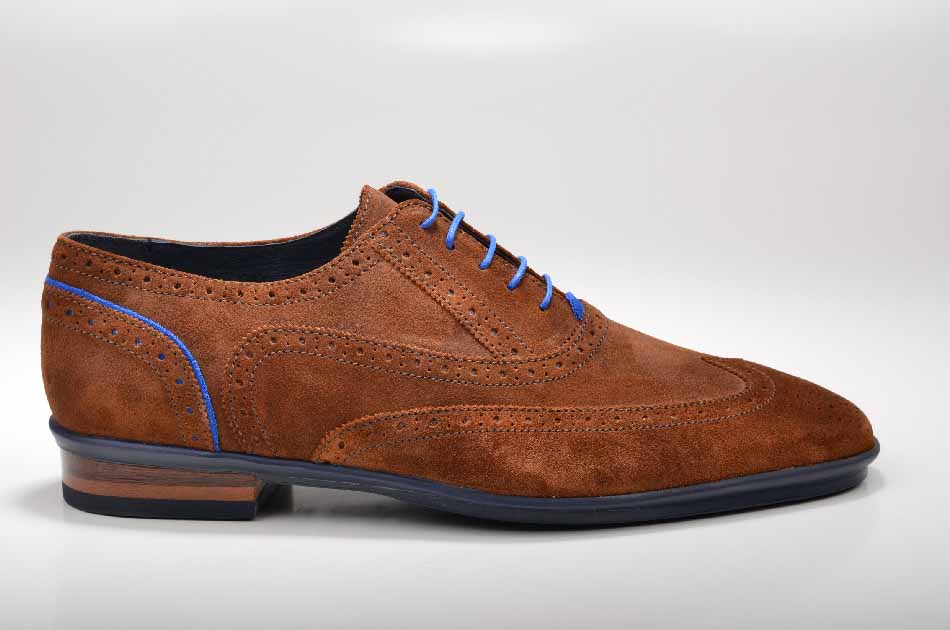
While suede may not be as durable as other types of smooth leather, its luxurious feel makes up for it.
Each type has its own unique properties that can cater to your personal style and needs.
The Allure of Exotic Leathers: Alligator and Crocodile
Alligator and crocodile leathers are the epitome of luxury. These exotic materials are highly sought after for their unique appeal, making them a favorite among fashion enthusiasts.
Scale Patterns
One of the most striking features of alligator and crocodile leathers is their distinct scale patterns. These patterns give the shoes an eye-catching visual appeal that sets them apart from other types of leather.
Whether it’s the bold, symmetrical scales of alligators or the more irregular and rugged scales of crocodiles, these leathers make a statement.
Natural Properties
In addition to their visual allure, alligator and crocodile leathers offer exceptional strength and longevity.
The natural properties of these animal hides make them incredibly durable, ensuring that your shoes will stand the test of time.
If you’re looking for a pair of shoes that will last for years to come, these exotic leathers are an excellent choice.
The Flip-side
However, it’s important to note that alligator and crocodile leather tend to be more expensive than other types of leather due to their rarity and meticulous sourcing process.
The skins used for these leathers come from wild animals that are carefully managed to ensure sustainability. This adds to their exclusivity and contributes to their higher price tag.
There is a wide variety available – from cowhide and calfskin to lizard skin and kangaroo leather. But if you’re looking for something truly unique and luxurious, then alligator or crocodile leather might be just what you need.
Unveiling the Beauty of Vegetable Tanned Leather
Vegetable-tanned leather is a classic and eco-friendly method of tanning that has been used for centuries. It involves using natural materials such as tree bark to create a rich and warm patina over time.
This type of leather is highly regarded for its durability and its ability to age gracefully, making it a popular choice for high-quality footwear.
Traditional and Environmentally Friendly Tanning
One of the key advantages of vegetable-tanned leather is its environmentally friendly nature.
Unlike other types of leather that may use harsh chemicals in the tanning process, vegetable tanning relies on natural substances that are better for both the environment and our health.
By using tree bark extracts, this method creates a wonderful patina on the leather while minimizing harm to the planet.
Durability and Aging Gracefully
Vegetable-tanned leather is renowned for its longevity. The natural tanning in this type of leather penetrate deep into the material, making it more resistant to wear and tear.
Over time, as you wear your vegetable-tanned shoes, they develop a unique character and charm with a beautiful patina that tells your story.
Versatile Use in Footwear
Due to its exceptional qualities, vegetable-tanned leather is commonly used in crafting high-quality footwear.
Whether it’s oxfords, loafers, or boots, this type of leather adds a touch of sophistication to any shoe style. Its texture can range from smooth and polished to velvety suede or nubuck finishes.
4 Simple Tips to Identify High-Quality Leather Shoes
When it comes to leather shoes, not all are created equal. The quality of the leather and the craftsmanship can greatly affect the shoe’s comfort, durability, and overall look.
Tip 1. Check the Type of Leather
As we’ve learned earlier, full-grain leather is the highest quality of leather. It’s durable, breathable, and ages beautifully. So if you’re looking for top-notch leather shoes, full-grain is your best bet.
On the other hand, bonded leather is the lowest quality and least durable. Remember, just because it’s labeled as “genuine” leather doesn’t mean it’s high-quality!
Tip 2. Examine the Craftsmanship
High-quality shoes are not just about the material; they’re also about the craftsmanship. Look for shoes with tight, even stitching and no loose threads.
The soles should be stitched, not glued to the upper part of the shoe. Also, check for any imperfections in the leather or inconsistencies in the dye.
Tip 3. Feel the Leather
High-quality leather should feel supple and flexible, not stiff or plasticky. It should have a rich, pleasant smell. If it smells like chemicals or synthetic materials, it’s probably low-quality.
Tip 4. Price Evaluation
While price isn’t always an indicator of quality, it’s rare to find high-quality leather shoes at a bargain price. Good materials and craftsmanship come at a cost.
However, consider it an investment – high-quality types of leather shoes can last for years with proper care.
Recap on Types of Leather Shoes
Alright, shoe enthusiasts, it’s time to wrap up our leather adventure! We’ve covered a lot of ground and explored the vast world of leather shoes.
So, here’s the deal: Understanding the various types of leather is crucial. From full grain to top grain and corrected grain leather, each has its own characteristics that can make or break your shoe game.
And let’s not forget about vegetable-tanned leather – it’s like the organic kale of the leather world!
Now that you’re armed with this knowledge (and a few bad puns), go forth and conquer the world in style! Find those perfect leather shoes that will make heads turn and feet envy.
Don’t settle for anything less than leathery perfection!
FAQ on Types of Leather Shoes
Are alligator skin shoes or crocodile leather shoes ethical?
The use of alligator or crocodile skins in fashion products is strictly regulated by international laws and conventions.
Reputable brands source their materials from sustainable farms where these animals are bred specifically for their skins. It ensures ethical practices while maintaining population control.
How do I care for my vegetable-tanned leather shoes?
Vegetable-tanned leather requires special care to maintain its natural beauty. Avoid excessive moisture exposure and use a mild soap solution or specialized cleaner for occasional cleaning.
Regularly apply a conditioner specifically designed for vegetable-tanned leather to keep it supple and nourished.
Is corrected grain leather durable?
Corrected-grain leather is often more resistant to scratches and stains due to its protective coating. However, it may not develop the same rich patina as full-grain leather over time.
Nevertheless, corrected grain leather shoes can still be durable and offer a polished appearance.
What is the difference between top-grain and full-grain leather?
Full-grain leather comes from the topmost layer of the hide, retaining its natural texture and imperfections. Top-grain leather undergoes additional processing to remove blemishes, resulting in a smoother surface.
Both are high-quality options, but full-grain leather tends to develop a unique character with age.
Can I wear Horween Kudu Leather shoes in rainy weather?
While Horween Kudu Leather has water-resistant properties, it is not entirely waterproof. It’s best to avoid wearing them in heavy rain or puddles.
If they do get wet, let them dry naturally away from direct heat sources and apply a suitable conditioner afterward. Regular maintenance will help prolong their lifespan.

